
One day I shall retire and move to Todamcold, Alaska and star in a wilderness TV show called Frozen Old Men of the North. Joining the tiny home nation, my cabin will be 100 square feet, so as to minimize my carbon footprint and to reduce the amount of firewood I would have to chop. With a drum cut stove, refrigerator/freezer, bunk, video game console, and big screen TV inside, there will be only room for one rifle and its ammunition, the specific selection the subject of discussion with my wife.
In my view, something between .270 to .338 in caliber, topped with a variable scope, 3x-10x as a maximum would be the ideal firearm. In my Wife’s view, the selection would be irrelevant as, if I intended to live in in isolation in Alaska… TV star or not, she would head to warm weather in Texas or California and a permanent visit with our children. She is not been good at playing “What if?”, “How about?” or “Humor my wonderful husband” Or, perhaps, she is too good of a player…
The Winchester Model 70 Featherweight
The Featherweight version of the Model 70 was first placed in production in 1952 to complement the standard Model 70 which had been in production since 1937… sort of like a K Harley following the E Harley. The Featherweight has been produced in a number of variations with differences related to: chamber, barrel length, stainless or carbon steel hardware, and grade of materials and finish. The Featherweight was Winchester’s attempt at making a light hunter’s version of the Model 70.
|
Winchester Model 70 Featherweight |
|
| Manufacturer | Browning Viana |
| Point of Origin | Portugal |
| Model | Model 70 Featherweight |
| Caliber | 30-06 Springfield |
| Magazine Capacity | 5 |
| Barrel Length | 22″ |
| Twist Rate | 1:10″ |
| Weight | 7 lbs 0 oz |
| Overall Length | 42 3/4″ |
| Stock | American Walnut |
| Checkering | Cut 20 LPI |
| Hardware | Blued Carbon Steel |
| Pull | 13 3/4“ |
| Drop at comb | 1/2“ |
| Drop at heel | 3/4“ |
| Non-optical sights | None |
| Trigger | M.O.A. Adjustable |
| Trigger Pull | *3 lbs. 12 oz. |
| Safety | Three Position |
| MSRP | $939.99 |
|
* Actual |
|
The current Featherweight, with a 22″ barrel and chambered for the 30-06 Springfield cartridge has a nominal weight of 7 lbs even. The Featherweight weight range, depending on chamber and barrel length, runs from 6 3/4 lbs to 7 1/4 lbs.
The Model 70’s Featherweight stock has a satin finished darkish walnut. Its lines are clean in a very traditional way, which makes the fancy, wraparound, ribbon paneled, point checkering… fitting, rather than ornate. I believe the patterns are 20 LPI machine cut. That said, the diamonds are clean, a bit sharp when new, but they do what they are suppose to do, provide a slip free surface.
The little cross bolt plug is nifty; functional and decorative and the recoil pad is excellent. Decelerator pads are not the newest on the market, but one of the best and not gummy or oversized like the type that can grab and hang up on clothing and get in the way of a shot. Swivel studs are included. The length of pull and drop at the comb and heel are all very comfortable.
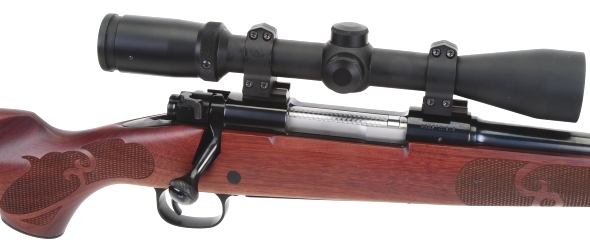
Weaver bases are tall in the back, low in the front, each two screw set is centered on the base, which allows the bases to be flipped front to back to juggle ring position on the scope tube, without the bases hanging over the receiver ring or ejection port. Even with low rings, the front scope bell seems a little high, but the needed clearance is for the bolt handle to clear a large eyepiece.
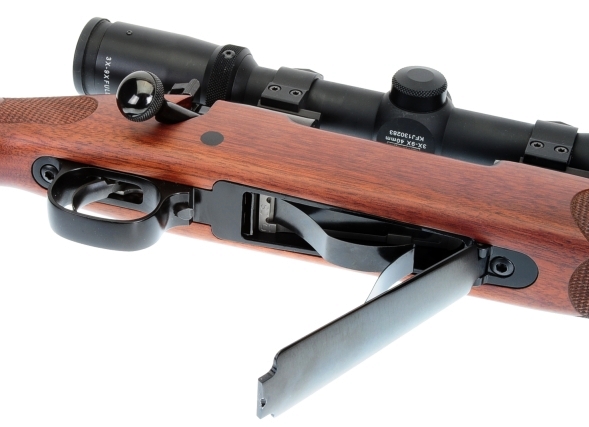
The trigger guard is fabricated from aluminum alloy, the trigger, the floorplate release mechanism and hinged floorplate itself are steel pieces. The M.O.A. trigger is a three lever design with no creep, a short pull and no overtravel. The trigger is factory preset to 3 1/2 lbs, however the trigger is adjustable for pull and overtravel.
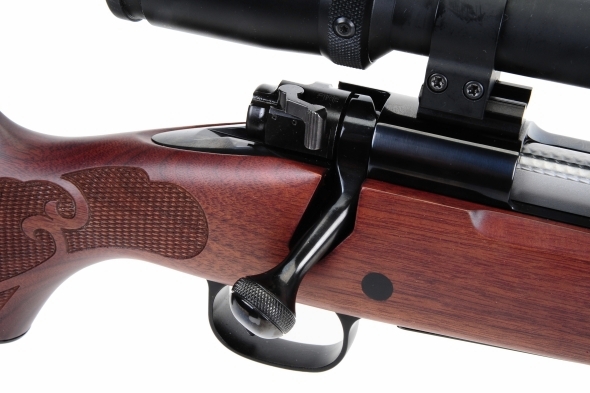
The safety is a three position type; full back for safe and bolt locked, middle position safe with bolt free to cycle, forward position is for safety off. Other nice touches are the knurled bolt knob and jeweled bolt body. The Model 70 Featherweight is a controlled round feed system; the cartridge is picked up by the extractor as the bolt is closed and held as it enters and is extracted from the chamber. The ejector is a fixed blade type so force of ejection is controlled by the speed at which the bolt is cycled.
A little more detail in pictures to make up for my lack of descriptive writing skills. When the bolt passes over a cartridge in the rifle’s magazine, the cartridge is lifted with the rim sliding up between the extractor hook and the bolt face, centered on the bolt face. If the bolt were removed, the cartridge would remain trapped in that position.

The bolt rides in slots cut into the sides of the receiver. For most of the travel, the bolt is supported by the lugs, the extractor and the gas block. At the end of travel, the bolt handle is rotated downward. The extractor and gas block remain fixed in the receiver guide slots, the bolt body and lugs rotate with the lugs engaging lug seats machines into the receiver. In the event of a primer or case failure, the extractor and gas block still residing in the guide slots will prevent gas from flowing back down the guide slots toward the shooter. It is a very safe set up and a long winded explanation on my part. It’s just that most firearms distinguish themselves in the details, like those indicated.

The Model 70 Featherweight uses spot glass bedding to assure a solid mess between stock and firearm, without brining in the effect of full wood to metal contact. Additionally, the wood is as sealed beneath the hardware as it is on the exposed surfaces; no moisture absorbing or heat shifting pressure points where wood touches metal.
The omnipotent 30-06 Springfield…
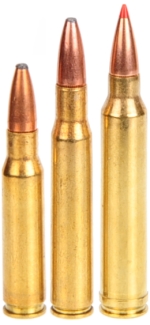
Sandwiched between 308 Winchester and 300 Winchester Magnum cartridges is the 30-06 Springfield. The 308 Winchester will not achieve 30-06 Springfield levels of performance and the 30-06 Springfield will not achieve 300 Winchester Magnum performance. The use of the terms, “Almost the same” and “hot handloads” are tossed around when trying to create the illusion that the smaller cartridges outperform the more powerful, however, they do not.
| Cartridge | Max Case Length “ |
Max Overall Length “ |
Case Capacity Gr/H20 |
Max Operating PSI |
SAAMI 165 Grain FPS |
Δ FPS |
| 308 Winchester | 2.014 | 2.800 | 56 | 62,000 | 2,870 | -145 |
| 30-06 Springfield | 2.494 | 3.340 | 68 | 60,000 | 3,015 | – |
| 300 Winchester Mag | 2.620 | 3.340 | 92 | 64,000 | 3,110 | +95 |
When the debate breaks out, proponents of a cartridge will immediately note Hornady Superformance or Buffalo Bore ballistics, but list Remington Managed Recoil ammo ballistics for the cartridges they wish to diminish. I know, human nature. The data with the greatest integrity can be found on the SAAMI sight in the form of pressure levels and nominal velocity for any given cartridge based on bullet weight.
Even for the folks who coax a little more velocity, the gain comes from operating near the top of the pressure limit and by carefully managing a pressure curve through optimal powder selection. Essentially the same think a handloader should do if pressure data is available. The delta entry is change from 30-06 Springfield performance. What about handloaders who can greatly exceed the reference velocities? Eventually pressure excesses will catch up to them and it won’t be pretty.
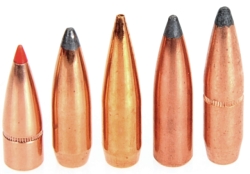
So what case can I make for the 30-06 Springfield? None. There is no case to make, only a preference to share and some explanation for the choice. It goes something like this…
I find no benefit of going with the 308 Winchester over the 30-06 Springfield. The shorter action rarely results in a measureable weight benefit. The longer 30-06 Springfield offers a higher level of ballistic performance. The 308 Winchester performs no better in a short barrel rifle than the 30-06 Springfield. The 30-06 Springfield better accommodates heavier bullet weights than the 308 Winchester. Do I throw my hands in the air in disgust if handed a 308 Winchester for hunting? Of course not. My preference is based upon a choice to make without already having a 308 Winchester in hand. So why discount the 300 Winchester Mag?
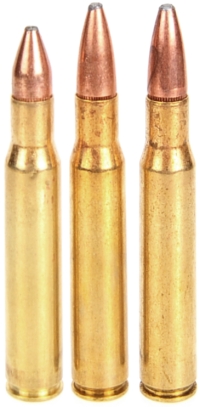 The Winchester Mag is best suited to a 24″ to 26″ barrel rifle. It handles heavy bullets better than either of the other two. It is a little more expensive to shoot and to reload. It has a bit heavier recoil and muzzle blast than the other two, enough to be noticeable. Loading down for medium size game, because of the 300 Winchester Mag’s high case capacity, requires a bit more consideration and a limited selection of powder that does not pressure spike at low density loading. Commercial availability of ammunition for all three is excellent: 129 – 308 Winchester, 119 – 30-06 Springfield, 74 – 300 Winchester Magnum.
The Winchester Mag is best suited to a 24″ to 26″ barrel rifle. It handles heavy bullets better than either of the other two. It is a little more expensive to shoot and to reload. It has a bit heavier recoil and muzzle blast than the other two, enough to be noticeable. Loading down for medium size game, because of the 300 Winchester Mag’s high case capacity, requires a bit more consideration and a limited selection of powder that does not pressure spike at low density loading. Commercial availability of ammunition for all three is excellent: 129 – 308 Winchester, 119 – 30-06 Springfield, 74 – 300 Winchester Magnum.
Actions ahead of words…
| Ammunition | Type | Bullet Grains |
Rated 24″ BBL FPS |
Recorded 22″ BBL FPS |
100 Yard Group “ |
| Remington Core-Lokt | PSP | 125 | 3140 | 2951 | 1.1 |
| Remington Core-Lokt | PSP | 150 | 2910 | 2887 | 0.9 |
| Remington Core-Lokt | PSP | 180 | 2700 | 2731 | 1.2 |
Test barrels are often longer than typical production barrels, which accounts for much of the disparity in velocity. Lighter bullet loads tend to amplify the differences. I felt accuracy was very good for a production rifle and factory ammunition. Remember, if this is to be placed into Internet gun forum accuracy context, just divide the table group size by three.
As a note, the focus of our project is the 30-06 Springfield cartridge, however, the Model 70 Featherweight is available in: 22-250 Rem, 243 Win, 7mm-08 Rem, 25-06 264 Win Mag, Rem, 270 Win, 270 WSM, 280 Rem, 308 Win, 30-06 Spfld, 300 Win Mag, 300 WSM, and 325 WSM.
Pause…
OK, with a solid Winchester Model 70 Featherweight in hand, chambered for the venerable 30-06 Springfield cartridge, the plan is to collect some live fire data from a collection of handloads that are hopefully useful for a range of medium to large game.


Email Notification